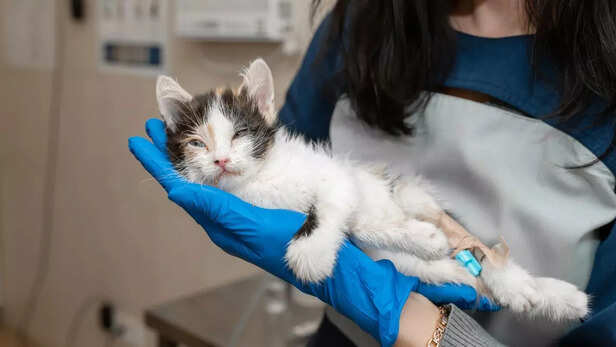Understanding neurological disorders in cats: Causes and symptoms
News Desk | Apr 07, 2025, 14:17 IST

Neurological disorders in cats can affect their brain, spinal cord, or nerves, leading to symptoms like seizures, balance issues, or behavior changes. Common conditions include epilepsy, vestibular disease, and brain tumors. Early diagnosis and treatment are crucial for managing symptoms and improving quality of life. Understanding neurological disorders in cats helps pet owners recognize warning signs and seek timely veterinary care.
Like humans, cats also suffer from neurological disorders that can affect their brain and body functions. Now, these conditions can be concerning even for pets. Serious neurological conditions often show signs and symptoms, if ignored, can lead to prolonged illness. The key to avoiding this situation is to ensure that your cats receive the best care possible.
What are neurological conditions?
Abnormalities or diseases that interfere with their motor and overall abilities. This can include congenital diseases that are present at birth or can develop through infections or unknown cases.
Let us explore further in this article what are some common neurological conditions in cats and how to treat them effectively.
1. Brain Tumors: It is A mass of abnormal issue that develops within the cat’s brain. So, in many cases, it leads to the growth of cancerous cells in the cat. Attaching itself to the brain tissues. Meningioma is the most common of all.
These growths can also be non-cancerous; in this inflammatory masses or parasitic infections can develop over time. The most recurring signal in the case of brain tumors are “seizures”; when this problem gets complex, seizures cause hyperactivity in the brain. Prolonged seizures can also lead to loss of consciousness, convulsions or even hypersalivation in cats. A vet might presume the cat has a brain tumor if it is older, as old cats develop a higher risk of having brain tumors, old being 10 years of age. Accurately diagnosing a brain tumor is required for further treatment. These diagnoses can be useful to rule out other causes of diseases.
2. Vestibular disease: It often affects the cat's inner ear and balance system, leading to a sudden loss of coordination. In simple terms, it is an ear infection that becomes inflammatory with time and can occur without any underlying cause.
Its symptoms often include dizziness, head tilt, loss of balance and walking in circles. Cats may appear disoriented or nauseous. This infection might require anti-inflammatory medication. Vestibular disease can be alarming but not life-threatening. Many cats might be able to recover in weeks or even months.
3. Epilepsy and seizures: Epilepsy in cats is a neurological condition marked by recurring seizures due to abnormal electrical activity in the brain. They can range from subtle twitching to staring spells and then full-on convulsions. Due to them, there can be loss of consciousness, muscle spasms and excessive drooling.
Genetic trauma, idiopathic origins can be their root cause. Cats have to undergo rigorous medical treatment, often giving them anticonvulsant medications to reduce the frequency of seizures. Cats with epilepsy should be kept calm, not under a stressful environment. With the right care, many cats can live stable and happy lives despite their condition.

4. Feline infectious peritonitis (FIP): Due to its complex nature, FIP requires an instant vet consultation. A very serious disease that is caused by strained mutations for feline coronavirus. Affects the younger cats mostly and can be either “wet or dry”.
Prolonged seizures, difficulty in walking, sudden aggressive behaviour and incoordination are some symptoms of this disease. FIP is considered to be very fatal. Early diagnosis and prompt medical intervention can improve the chances of survival in cats. Arrival of treatment such as GS-441524 has shown promising effects in recent years, and there have been fewer casualties since its inception.
5. Spinal cord disorders: Though its symptoms may vary on its severity. Imaging diagnosis techniques such as MRI and CT scans can help in early diagnosis. This disorder in cats involves damage or compression of the spinal cord due to trauma, intervertebral disc disease and tumors. Sometimes, this leads to paralysis or partial paralysis in cats. Its symptoms include muscle weakness, pain, incontinence difficulty in walking and jumping. Long-term care often includes supportive aids and environmental modifications to assist the cat’s mobility.
Signs that your cat might be suffering from a neurological problem:
- Seizures
- Head tilt
- Circling behaviour
- Staggering
- Muscle tremors
- Loss of bladder
- Sudden blindness
- Incontinence
- Changes in behaviour and personality

Diagnosis
- Spinal fluid analysis
- Blood or urine testing
- Detailed history and physical exam
- MRI or CT scans for brain/ spinal imaging
Your dedication and awareness can make a huge difference in the well-being of your pet. These conditions are complex but are not something that can’t be resolved with immediate care and attention.
Discover expert advice and the latest tips on pet care, training, health, and more. Stay updated with all things pets at Times Pets!
What are neurological conditions?
Abnormalities or diseases that interfere with their motor and overall abilities. This can include congenital diseases that are present at birth or can develop through infections or unknown cases.
Let us explore further in this article what are some common neurological conditions in cats and how to treat them effectively.

Neurological problems in cats
1. Brain Tumors: It is A mass of abnormal issue that develops within the cat’s brain. So, in many cases, it leads to the growth of cancerous cells in the cat. Attaching itself to the brain tissues. Meningioma is the most common of all.
These growths can also be non-cancerous; in this inflammatory masses or parasitic infections can develop over time. The most recurring signal in the case of brain tumors are “seizures”; when this problem gets complex, seizures cause hyperactivity in the brain. Prolonged seizures can also lead to loss of consciousness, convulsions or even hypersalivation in cats. A vet might presume the cat has a brain tumor if it is older, as old cats develop a higher risk of having brain tumors, old being 10 years of age. Accurately diagnosing a brain tumor is required for further treatment. These diagnoses can be useful to rule out other causes of diseases.
2. Vestibular disease: It often affects the cat's inner ear and balance system, leading to a sudden loss of coordination. In simple terms, it is an ear infection that becomes inflammatory with time and can occur without any underlying cause.
Its symptoms often include dizziness, head tilt, loss of balance and walking in circles. Cats may appear disoriented or nauseous. This infection might require anti-inflammatory medication. Vestibular disease can be alarming but not life-threatening. Many cats might be able to recover in weeks or even months.
3. Epilepsy and seizures: Epilepsy in cats is a neurological condition marked by recurring seizures due to abnormal electrical activity in the brain. They can range from subtle twitching to staring spells and then full-on convulsions. Due to them, there can be loss of consciousness, muscle spasms and excessive drooling.
Genetic trauma, idiopathic origins can be their root cause. Cats have to undergo rigorous medical treatment, often giving them anticonvulsant medications to reduce the frequency of seizures. Cats with epilepsy should be kept calm, not under a stressful environment. With the right care, many cats can live stable and happy lives despite their condition.

Neurological disorders in cats
4. Feline infectious peritonitis (FIP): Due to its complex nature, FIP requires an instant vet consultation. A very serious disease that is caused by strained mutations for feline coronavirus. Affects the younger cats mostly and can be either “wet or dry”.
Prolonged seizures, difficulty in walking, sudden aggressive behaviour and incoordination are some symptoms of this disease. FIP is considered to be very fatal. Early diagnosis and prompt medical intervention can improve the chances of survival in cats. Arrival of treatment such as GS-441524 has shown promising effects in recent years, and there have been fewer casualties since its inception.
5. Spinal cord disorders: Though its symptoms may vary on its severity. Imaging diagnosis techniques such as MRI and CT scans can help in early diagnosis. This disorder in cats involves damage or compression of the spinal cord due to trauma, intervertebral disc disease and tumors. Sometimes, this leads to paralysis or partial paralysis in cats. Its symptoms include muscle weakness, pain, incontinence difficulty in walking and jumping. Long-term care often includes supportive aids and environmental modifications to assist the cat’s mobility.
Signs that your cat might be suffering from a neurological problem:
- Seizures
- Head tilt
- Circling behaviour
- Staggering
- Muscle tremors
- Loss of bladder
- Sudden blindness
- Incontinence
- Changes in behaviour and personality

Cat neurological diseases
Diagnosis
- Spinal fluid analysis
- Blood or urine testing
- Detailed history and physical exam
- MRI or CT scans for brain/ spinal imaging
Your dedication and awareness can make a huge difference in the well-being of your pet. These conditions are complex but are not something that can’t be resolved with immediate care and attention.
- What are the symptoms of cat neurological disorders?
Seizures, incontinence, head tilting, staggering, loss of bladder, sudden blindness, etc. - What mental disorders can cats have?
Compulsive eating (pica), aggression disorder, feline dementia, phobias (of thunder, vacuum cleaner, etc) and depression. - What neurological conditions can my cat have?
Epilepsy and seizures, Cerebellar hypoplasia, vestibular disease and feline infectious peritonitis. - How do I know if my cat has brain damage?
Look for certain symptoms such as sudden behaviour changes, loss of coordination, abnormal eye movement, disorientation, appetite changes and unusual vocalisation. - How do you test for
neurological disorders in cats ?
Observe the symptoms, do some diagnostic tests such as MRI or CT scans. Consult a vet before giving any medications and always go for a neurological exam such as to check for mental awareness and alertness.
Discover expert advice and the latest tips on pet care, training, health, and more. Stay updated with all things pets at Times Pets!
